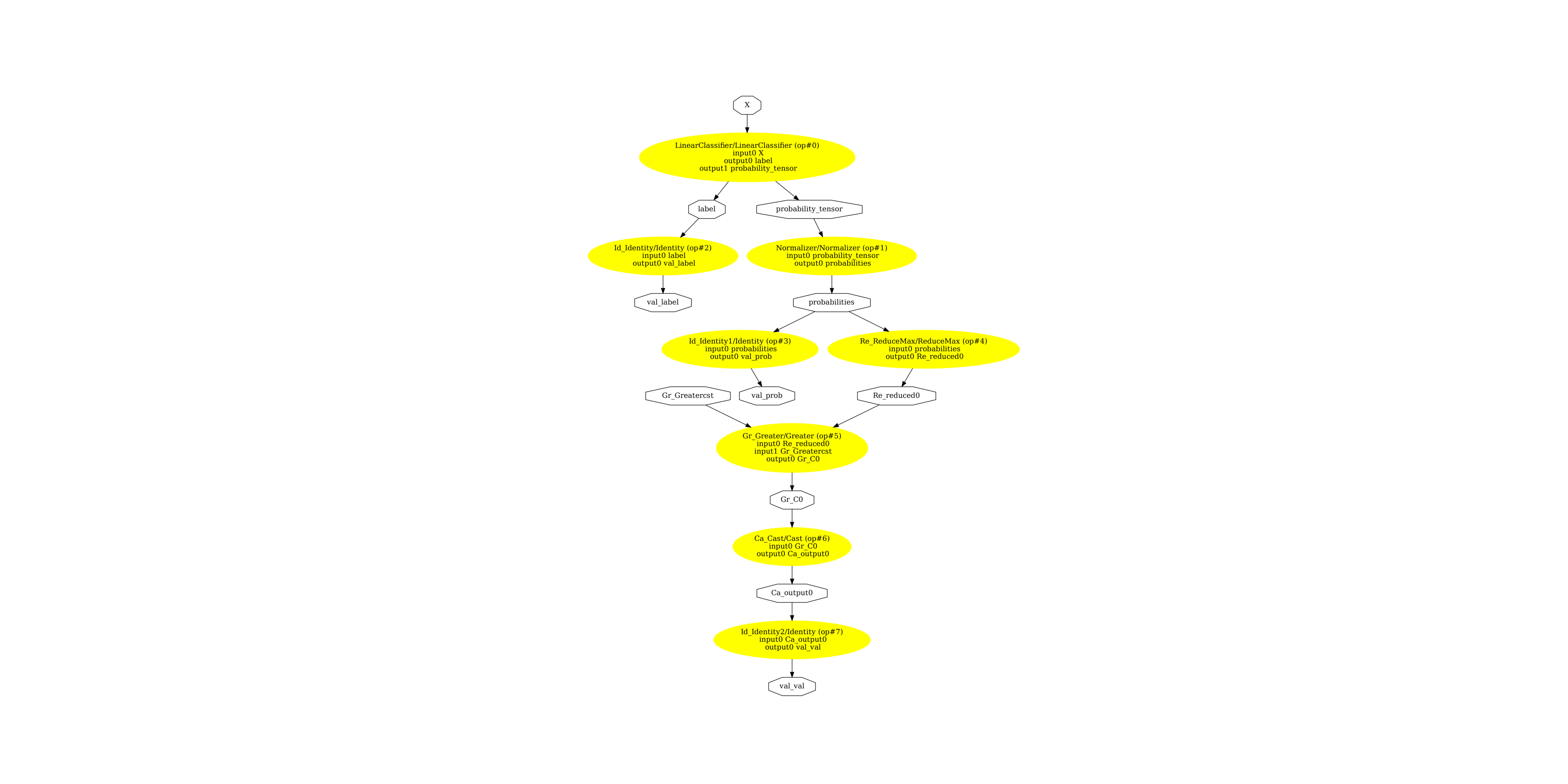注意
转到末尾 下载完整的示例代码。
当自定义模型既不是分类器也不是回归器(替代方案)¶
注意
本示例重写了 当自定义模型既不是分类器也不是回归器,通过使用示例 玩转 ONNX 算子 中提出的语法来编写自定义转换器、形状计算器和解析器。
scikit-learn 的 API 指定回归器产生一个输出,而分类器产生两个输出:预测标签和概率。这里的目标是添加第三个结果,用于指示概率是否高于给定阈值。这在 `validate` 方法中实现。
Iris 和评分¶
创建了一个新类,它训练任何分类器并实现上述 `validate` 方法。
import inspect
import numpy as np
import skl2onnx
import onnx
import sklearn
from sklearn.base import ClassifierMixin, BaseEstimator, clone
from sklearn.datasets import load_iris
from sklearn.linear_model import LogisticRegression
from sklearn.model_selection import train_test_split
from skl2onnx import update_registered_converter
import os
from onnx.tools.net_drawer import GetPydotGraph, GetOpNodeProducer
import onnxruntime as rt
from skl2onnx import to_onnx, get_model_alias
from skl2onnx.proto import onnx_proto
from skl2onnx.common.data_types import FloatTensorType, Int64TensorType
from skl2onnx.algebra.onnx_ops import (
OnnxGreater,
OnnxCast,
OnnxReduceMaxApi18,
OnnxIdentity,
)
from skl2onnx.algebra.onnx_operator import OnnxSubEstimator
import matplotlib.pyplot as plt
class ValidatorClassifier(BaseEstimator, ClassifierMixin):
def __init__(self, estimator=None, threshold=0.75):
ClassifierMixin.__init__(self)
BaseEstimator.__init__(self)
if estimator is None:
estimator = LogisticRegression(solver="liblinear")
self.estimator = estimator
self.threshold = threshold
def fit(self, X, y, sample_weight=None):
sig = inspect.signature(self.estimator.fit)
if "sample_weight" in sig.parameters:
self.estimator_ = clone(self.estimator).fit(
X, y, sample_weight=sample_weight
)
else:
self.estimator_ = clone(self.estimator).fit(X, y)
return self
def predict(self, X):
return self.estimator_.predict(X)
def predict_proba(self, X):
return self.estimator_.predict_proba(X)
def validate(self, X):
pred = self.predict_proba(X)
mx = pred.max(axis=1)
return (mx >= self.threshold) * 1
data = load_iris()
X, y = data.data, data.target
X_train, X_test, y_train, y_test = train_test_split(X, y)
model = ValidatorClassifier()
model.fit(X_train, y_train)
现在让我们衡量指示器,该指示器指示预测概率是否高于阈值。
print(model.validate(X_test))
[0 1 1 0 1 1 1 0 1 1 1 1 0 0 1 0 0 0 1 1 1 1 1 1 0 0 0 1 1 0 1 1 0 0 1 0 0
1]
转换为 ONNX¶
由于库不知道与此新模型关联的任何转换器,因此转换会失败。
try:
to_onnx(model, X_train[:1].astype(np.float32), target_opset=12)
except RuntimeError as e:
print(e)
Unable to find a shape calculator for type '<class '__main__.ValidatorClassifier'>'.
It usually means the pipeline being converted contains a
transformer or a predictor with no corresponding converter
implemented in sklearn-onnx. If the converted is implemented
in another library, you need to register
the converted so that it can be used by sklearn-onnx (function
update_registered_converter). If the model is not yet covered
by sklearn-onnx, you may raise an issue to
https://github.com/onnx/sklearn-onnx/issues
to get the converter implemented or even contribute to the
project. If the model is a custom model, a new converter must
be implemented. Examples can be found in the gallery.
自定义转换器¶
我们重用了 为自己的模型编写自己的转换器 的部分代码。形状计算器定义了转换模型每个输出的形状。
def validator_classifier_shape_calculator(operator):
input0 = operator.inputs[0] # first input in ONNX graph
outputs = operator.outputs # outputs in ONNX graph
op = operator.raw_operator # scikit-learn model (mmust be fitted)
if len(outputs) != 3:
raise RuntimeError("3 outputs expected not {}.".format(len(outputs)))
N = input0.type.shape[0] # number of observations
C = op.estimator_.classes_.shape[0] # dimension of outputs
outputs[0].type = Int64TensorType([N]) # label
outputs[1].type = FloatTensorType([N, C]) # probabilities
outputs[2].type = Int64TensorType([C]) # validation
然后是转换器。
def validator_classifier_converter(scope, operator, container):
input0 = operator.inputs[0] # first input in ONNX graph
outputs = operator.outputs # outputs in ONNX graph
op = operator.raw_operator # scikit-learn model (mmust be fitted)
opv = container.target_opset
# The model calls another one. The class `OnnxSubEstimator`
# calls the converter for this operator.
model = op.estimator_
onnx_op = OnnxSubEstimator(model, input0, op_version=opv, options={"zipmap": False})
rmax = OnnxReduceMaxApi18(onnx_op[1], axes=[1], keepdims=0, op_version=opv)
great = OnnxGreater(
rmax, np.array([op.threshold], dtype=np.float32), op_version=opv
)
valid = OnnxCast(great, to=onnx_proto.TensorProto.INT64, op_version=opv)
r1 = OnnxIdentity(onnx_op[0], output_names=[outputs[0].full_name], op_version=opv)
r2 = OnnxIdentity(onnx_op[1], output_names=[outputs[1].full_name], op_version=opv)
r3 = OnnxIdentity(valid, output_names=[outputs[2].full_name], op_version=opv)
r1.add_to(scope, container)
r2.add_to(scope, container)
r3.add_to(scope, container)
然后是注册。
update_registered_converter(
ValidatorClassifier,
"CustomValidatorClassifier",
validator_classifier_shape_calculator,
validator_classifier_converter,
)
以及转换…
try:
to_onnx(model, X_test[:1].astype(np.float32), target_opset=12)
except RuntimeError as e:
print(e)
3 outputs expected not 2.
转换失败,因为库期望模型像一个产生两个输出的分类器一样运行。我们需要添加一个自定义解析器来告知库此模型产生三个输出。
自定义解析器¶
def validator_classifier_parser(scope, model, inputs, custom_parsers=None):
alias = get_model_alias(type(model))
this_operator = scope.declare_local_operator(alias, model)
# inputs
this_operator.inputs.append(inputs[0])
# outputs
val_label = scope.declare_local_variable("val_label", Int64TensorType())
val_prob = scope.declare_local_variable("val_prob", FloatTensorType())
val_val = scope.declare_local_variable("val_val", Int64TensorType())
this_operator.outputs.append(val_label)
this_operator.outputs.append(val_prob)
this_operator.outputs.append(val_val)
# ends
return this_operator.outputs
注册。
update_registered_converter(
ValidatorClassifier,
"CustomValidatorClassifier",
validator_classifier_shape_calculator,
validator_classifier_converter,
parser=validator_classifier_parser,
)
再次转换。
model_onnx = to_onnx(model, X_test[:1].astype(np.float32), target_opset=12)
最终测试¶
我们现在需要检查 ONNX 的结果是否相同。
X32 = X_test[:5].astype(np.float32)
sess = rt.InferenceSession(
model_onnx.SerializeToString(), providers=["CPUExecutionProvider"]
)
results = sess.run(None, {"X": X32})
print("--labels--")
print("sklearn", model.predict(X32))
print("onnx", results[0])
print("--probabilities--")
print("sklearn", model.predict_proba(X32))
print("onnx", results[1])
print("--validation--")
print("sklearn", model.validate(X32))
print("onnx", results[2])
--labels--
sklearn [1 1 0 2 1]
onnx [1 1 0 2 1]
--probabilities--
sklearn [[1.03067720e-02 6.69865221e-01 3.19828007e-01]
[5.10515802e-02 7.83682562e-01 1.65265858e-01]
[8.21085518e-01 1.78750465e-01 1.64017433e-04]
[1.49114641e-03 3.56498823e-01 6.42010031e-01]
[1.58208552e-01 7.70805757e-01 7.09856915e-02]]
onnx [[1.0306807e-02 6.6986507e-01 3.1982812e-01]
[5.1051572e-02 7.8368247e-01 1.6526584e-01]
[8.2108551e-01 1.7875044e-01 1.6404319e-04]
[1.4912011e-03 3.5649881e-01 6.4201003e-01]
[1.5820849e-01 7.7080584e-01 7.0985720e-02]]
--validation--
sklearn [0 1 1 0 1]
onnx [0 1 1 0 1]
看起来不错。
显示 ONNX 图¶
pydot_graph = GetPydotGraph(
model_onnx.graph,
name=model_onnx.graph.name,
rankdir="TB",
node_producer=GetOpNodeProducer(
"docstring", color="yellow", fillcolor="yellow", style="filled"
),
)
pydot_graph.write_dot("validator_classifier.dot")
os.system("dot -O -Gdpi=300 -Tpng validator_classifier.dot")
image = plt.imread("validator_classifier.dot.png")
fig, ax = plt.subplots(figsize=(40, 20))
ax.imshow(image)
ax.axis("off")

(np.float64(-0.5), np.float64(3557.5), np.float64(4934.5), np.float64(-0.5))
此示例使用的版本
print("numpy:", np.__version__)
print("scikit-learn:", sklearn.__version__)
print("onnx: ", onnx.__version__)
print("onnxruntime: ", rt.__version__)
print("skl2onnx: ", skl2onnx.__version__)
numpy: 2.3.1
scikit-learn: 1.6.1
onnx: 1.19.0
onnxruntime: 1.23.0
skl2onnx: 1.19.1
脚本总运行时间:(0 分钟 3.326 秒)